Early shoes: 1250 - 1799
The earliest surviving King's Lynn shoes date back to about 1250. Archaeologists excavating in King's Lynn in the 1960s found well preserved remains of leather shoes almost everywhere they dug. They found over 400 shoe soles, a number of boot and shoe uppers, together with many leather scraps from cobbling (shoe mending).
The leather used has been identified as coming from either goat skin or cow hide. All the boots and shoes found in the town were made using the turn shoe technique where the shoe is made inside out and then turned to produce water-tight seams.
Secret shoes
Builders sometimes find worn-out shoes hidden in a building. They were often concealed near the entrance point to the house such as a chimney, window or doorway. This practice was thought to bring good luck and protect the home from evil spirits. The shoes are always heavily worn. Very often there is only one shoe, and many of the shoes are children's.
The earliest shoes used in this way date back to about 1500. No one knows how this practice began. These finds are important survivals because they show the everyday shoes worn by householders. Northampton Museum keeps a record of the concealed shoes and knows of over 1900 examples from around the UK.
Prized possessions
As well as discoveries of everyday shoes by archaeologists and builders, other early survivals may be prized, delicate and special shoes kept and handed down through the generations as heirlooms.
Such shoes may have been made from silk and coloured kid leather or embroidered brocade. They were only worn occasionally, more carefully kept, and admired for their craftsmanship over the years.
Timeline
1250 - 1799
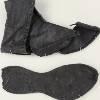
Early shoes - The earliest surviving King's Lynn shoes date back to about 1250. Archaeologists excavating in King's Lynn in the 1960s found well preserved remains of leather shoes almost everywhere they dug.
1800s
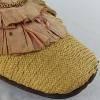
Victorian shoes - Before the mass production of shoes, towns like King's Lynn had their own craftsmen who made and mended boots and shoes. 'White's Norfolk Directory' of 1845 lists 67 boot and shoemakers trading in King's Lynn.
1920s
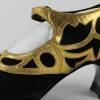
Walking jewellery - The most popular style of footwear was the bar shoe. It had a simple design with a heel, single strap and button to fasten. Shoes were made from satin, brightly coloured leathers and exotic skins.
1930s
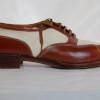
Ready-to-wear - During this period the look of the High Street changed. Department stores such as Marks and Spencer and Burtons the Tailor opened shops in King's Lynn. Local, well established, independent retailers continued to trade.
1940s
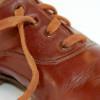
Footwear during the war years - On the Home Front clothing was practical. People were encouraged to 'make do and mend' - modifying the clothing that they already had. Shoe polish wasn't available so people were encouraged to use a cut potato to shine their shoes.
1950s
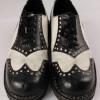
Fun and fashion - During the 1950s young people had more disposable income resulting in a development of youth fashion. These thick crepe-sole shoes are commonly known as creepers. Local cobblers began to refine the creeper to include larger soles.
1960s
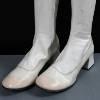
Shoes a-go-go - Local cobblers began to refine the creeper to include larger soles. Go-go boots may have been named after go-go dancing in nightclubs.
1970s
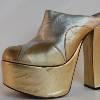
A platform for shoes - In the early 1970s popular fashion and lifestyle magazine 'Vogue' declared "there are no rules in the fashion game now." Disco music inspired many fashions of the late 1970s.
Modern day

High tech and the high street - Specialist sport shoe manufacturers are now using cutting-edge technology to enhance the user's performance. These new developments are changing what a shoe is, and what a shoe can do for its wearer.








